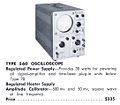560: Difference between revisions
No edit summary |
(template, cat) |
||
| Line 1: | Line 1: | ||
The Tektronix 560 is a scope [[introduced in 1961]] which uses 50 and 60 series plug-ins | {{Oscilloscope Sidebar | | ||
title=Tektronix 560 | | |||
summary=1 MHz scope | | |||
image=Tek 560 1.jpeg | | |||
caption=Tektronix 567 front | | |||
introduced=1961 | | |||
discontinued=1962 | | |||
* [http://w140.com/tek_560_ocr.pdf Tektronix 560 Manual (OCR, PDF)] | |||
* [http://w140.com/tek_560_560_product_release.pdf Tektronix 560 and 561 Product Release (PDF)] | |||
manuals= | |||
}} | |||
The '''Tektronix 560''' is a scope [[introduced in 1961]] which uses 50 and 60 series plug-ins | |||
for both the vertical and horizontal deflection. | for both the vertical and horizontal deflection. | ||
It is the first of the [[560-series scopes]], which contain no amplifier stages, | It is the first of the [[560-series scopes]], which contain no amplifier stages, | ||
requiring the plug-ins to directly drive the CRT deflection plates. | requiring the plug-ins to directly drive the CRT deflection plates. | ||
While promoted by Tek as having the advantage of | While promoted by Tek as having the advantage of | ||
“not limited by additional circuitry between the plug-in and the deflection plates”, | ''“not limited by additional circuitry between the plug-in and the deflection plates”'', | ||
this configuration has | this configuration has the significant disadvantage that | ||
gain or sweep need to be calibrated individually each time | |||
a plug-in is swapped to even get crude accuracy, as the raw | |||
deflection factor of the CRT varies to a relatively large | |||
degree between units, and the mainframe has no circuitry to normalize | |||
this difference. | |||
It may be for this reason that Tektronix referred to the 560 | |||
series mainframes as “indicators” rather than oscilloscopes. | |||
In scopes that have amplifiers in the mainframe, this step can be skipped, | |||
as doing so only tunes the accuracy to a small amount of additional precision. | as doing so only tunes the accuracy to a small amount of additional precision. | ||
The only circuit in the 560 apart from the CRT circuits and | |||
power supply is a voltage/timing calibrator. | |||
The 560 was introduced along with the similar [[561]] in 1961. | The 560 was introduced along with the similar [[561]] in 1961. | ||
A rack model was never offered. | A rack model was never offered. | ||
Both of the mainframes use conventional 5” round CRTs | Both of the mainframes use conventional 5” round CRTs with glass envelopes. | ||
The maximum system bandwidth of the 560 is 1 MHz. | The maximum system bandwidth of the 560 is 1 MHz. | ||
The 561 also supports the 70 series plug-ins | |||
Certain members of the 70 series vertical amplifiers give a system bandwidth in the 561 | The 561 also supports the 70 series plug-ins which are not compatible with the 560. | ||
Certain members of the 70 series vertical amplifiers give a system bandwidth of 4 MHz in the 561. | |||
The later 2 and 3 series plug-ins can not be used in the 560 or 561, as they consume more power. | The later 2 and 3 series plug-ins can not be used in the 560 or 561, as they consume more power. | ||
The 560 and 561 were short lived | The 560 and 561 were short-lived. Both were replaced by the 561A, which offered | ||
several performance improvements, within less than a year. | |||
which offered several performance improvements. | |||
==Specifications== | |||
[[Category:Specifications needed]]''please add'' | |||
==Pictures== | |||
<gallery> | <gallery> | ||
| Line 42: | Line 59: | ||
[[Category:560 series scopes]] | [[Category:560 series scopes]] | ||
Revision as of 07:14, 18 August 2014
The Tektronix 560 is a scope introduced in 1961 which uses 50 and 60 series plug-ins for both the vertical and horizontal deflection.
It is the first of the 560-series scopes, which contain no amplifier stages, requiring the plug-ins to directly drive the CRT deflection plates. While promoted by Tek as having the advantage of “not limited by additional circuitry between the plug-in and the deflection plates”, this configuration has the significant disadvantage that gain or sweep need to be calibrated individually each time a plug-in is swapped to even get crude accuracy, as the raw deflection factor of the CRT varies to a relatively large degree between units, and the mainframe has no circuitry to normalize this difference. It may be for this reason that Tektronix referred to the 560 series mainframes as “indicators” rather than oscilloscopes.
In scopes that have amplifiers in the mainframe, this step can be skipped, as doing so only tunes the accuracy to a small amount of additional precision.
The only circuit in the 560 apart from the CRT circuits and power supply is a voltage/timing calibrator.
The 560 was introduced along with the similar 561 in 1961. A rack model was never offered. Both of the mainframes use conventional 5” round CRTs with glass envelopes. The maximum system bandwidth of the 560 is 1 MHz.
The 561 also supports the 70 series plug-ins which are not compatible with the 560. Certain members of the 70 series vertical amplifiers give a system bandwidth of 4 MHz in the 561. The later 2 and 3 series plug-ins can not be used in the 560 or 561, as they consume more power.
The 560 and 561 were short-lived. Both were replaced by the 561A, which offered several performance improvements, within less than a year.
Specifications
please add
Pictures
-
Description in 1962 Catalog
-
-
-
-
-






